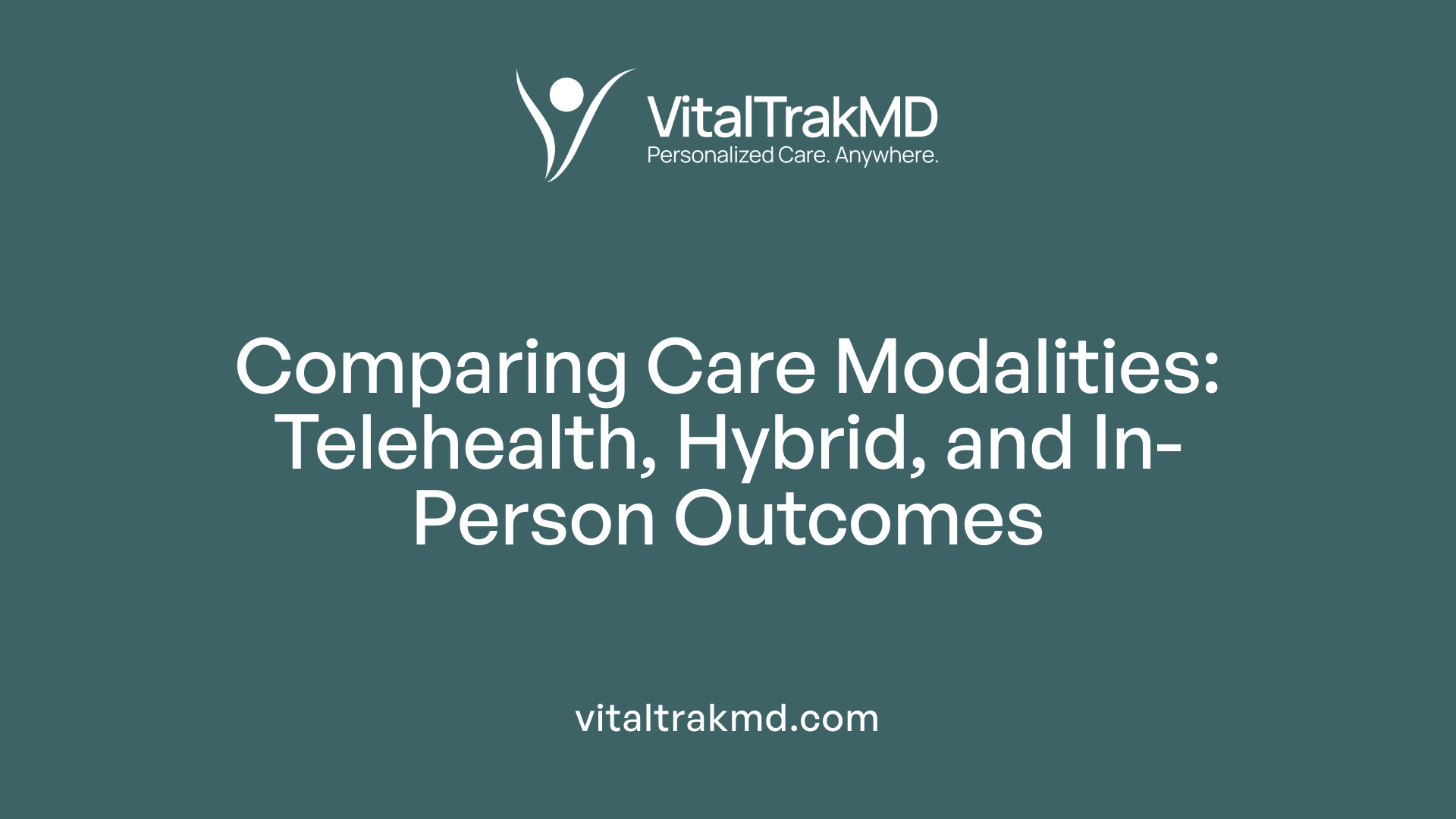Energy Challenges? Why Hybrid Care Can Be a Better Option Than In-Person Consults

Adapting to Energy Challenges with Hybrid Healthcare
As energy challenges become increasingly prominent worldwide, healthcare systems are exploring innovative models that optimize resource utilization while maintaining high-quality care. Hybrid care, which combines virtual and in-person services, emerges as a sustainable, efficient alternative to traditional healthcare delivery. This article delves into how hybrid healthcare addresses systemic issues, enhances patient access, and leverages technology to create resilient health systems capable of thriving amid energy and resource constraints.
The Role of Technology in Supporting Hybrid Healthcare and Its Future
How does technology support hybrid healthcare approaches?
Technology underpins the development and efficiency of hybrid healthcare models by enabling seamless integration of virtual and in-person care services. Telehealth platforms facilitate virtual consultations, allowing patients to connect with healthcare providers from remote locations, reducing travel and wait times. Wearable devices and remote patient monitoring systems provide real-time data on vital signs and health metrics, helping clinicians track patient outcomes outside the clinical setting.
Tools such as secure messaging, video conferencing, and digital health records ensure effective communication and data sharing. Artificial intelligence (AI) and data analytics enhance diagnostic accuracy, personalize treatment plans, and improve resource management. These innovations help address workforce shortages by extending the reach of healthcare providers and making care delivery more flexible.
What does the future hold for technology in healthcare systems?
The future of healthcare is set to be increasingly digital, with AI-driven diagnostics, predictive analytics, and sophisticated wearable technology playing central roles. These advancements will enable more proactive, personalized care tailored to individual patient needs. As digital tools become more user-friendly and integrated with existing systems, accessibility improves for diverse populations, including rural, elderly, or non-English speaking patients.
Moreover, innovations like virtual reality, augmented reality, and next-generation telehealth platforms will further enhance patient engagement and provider efficiency. Policymakers and healthcare organizations are expected to continue investing in digital infrastructure and regulations that support data security, interoperability, and equitable access.
In summary, technology is essential for shaping more accessible, efficient, and patient-centered healthcare models. It will facilitate a move away from traditional, facility-bound care towards a more flexible, technology-enabled framework that benefits both patients and providers, especially in a rapidly evolving health landscape.
Expanding Healthcare Access Through Virtual Services
 Hybrid healthcare models combine in-person visits with virtual services, transforming how patients access medical care. This approach leverages teleconsultations, remote monitoring, and digital tools to reach a broader patient population, including those in rural or underserved areas.
Hybrid healthcare models combine in-person visits with virtual services, transforming how patients access medical care. This approach leverages teleconsultations, remote monitoring, and digital tools to reach a broader patient population, including those in rural or underserved areas.
Remote consultations allow patients to connect with healthcare providers from their homes, reducing travel time and making specialist care more accessible. Virtual triage helps prioritize urgent cases and guides patients to the appropriate care settings efficiently, decreasing unnecessary emergency visits and hospitalizations.
For residents in remote locations, virtual services bridge the geographical gap, providing timely diagnoses, follow-ups, and ongoing management of chronic conditions. Programs like hospital-at-home, supported by remote monitoring devices, allow patients to receive hospital-level care while remaining at home, minimizing hospital stays and improving comfort.
The integration of technology also addresses healthcare staffing shortages. Telehealth enables providers to extend their reach beyond physical clinics, offering flexible schedules and expanding the capacity to serve more patients.
In summary, hybrid healthcare enhances access by offering flexible, patient-centered virtual options combined with traditional care, ensuring health services are more equitable, timely, and efficient for all communities.
Strategic Benefits and Cost-Effectiveness of Hybrid Healthcare Models

What are the benefits and strategic advantages of hybrid healthcare models over traditional in-person consultations?
Hybrid healthcare models combine virtual and in-person care, offering multiple advantages for healthcare organizations and patients. One primary benefit is increased accessibility, especially for individuals in remote, rural, or underserved areas. Patients can receive routine check-ups, follow-up care, and chronic disease management without the need for travel, reducing transportation costs and time.
From a resource perspective, hybrid models help optimize utilization of healthcare facilities and personnel. They decrease unnecessary visits and hospital admissions, leading to lower operational costs for healthcare providers. Virtual consultations require less physical space and can be scheduled more flexibly, improving overall efficiency.
The flexibility of hybrid care also contributes to staff satisfaction. Remote work options and flexible scheduling help reduce staff burnout, which has been a significant concern in healthcare. This adaptability supports organizational resilience by allowing healthcare services to continue smoothly during crises, such as pandemics or natural disasters.
Moreover, hybrid care ensures that healthcare providers stay updated with innovative practices, improving the quality of care and patient outcomes. It fosters a patient-centered approach, aligning services with patient preferences for convenience and comprehensive management.
In summary, hybrid healthcare models provide strategic advantages by reducing costs, better utilizing resources, supporting staff well-being, and enhancing the overall resilience of healthcare systems. They position organizations as forward-thinking, capable of adapting to changing healthcare demands while maintaining high standards of care.
Research Evidence Supporting Hybrid Care Implementation

What evidence supports the implementation of hybrid care in healthcare delivery?
Recent research underscores the promising potential of hybrid care models—combining telehealth with traditional in-person visits—to improve healthcare outcomes and efficiency. Studies emphasize that effectiveness-implementation research approaches can provide a comprehensive assessment of both the clinical benefits and practical aspects of adopting hybrid models.
By leveraging frameworks such as RE-AIM (Reach, Effectiveness, Adoption, Implementation, Maintenance), CFIR (Consolidated Framework for Implementation Research), and PROCTOR’s taxonomy, researchers can systematically explore factors influencing successful integration. These tools help identify barriers, facilitators, and contextual influences that affect how well hybrid care is adopted, sustained, and scaled.
For instance, the 'Your Care Needs You' intervention demonstrated that flexible, patient-centered components, supported by strong leadership and organizational readiness, fostered higher patient participation. These insights highlight the importance of tailoring hybrid care to local settings and ensuring that leadership and infrastructure align.
Educational efforts, new protocols, and technological support, guided by such frameworks, contribute significantly to favorable outcomes.
Case studies indicate that hybrid models enhance access, reduce unnecessary hospital visits, and maintain or improve management of chronic diseases like diabetes and lung cancer. Moreover, they facilitate better patient engagement and satisfaction.
Overall, evidence suggests that when hybrid care is thoughtfully designed, considering organizational context and supported by strategic frameworks, it can deliver effective, sustainable, and patient-centered healthcare.
| Aspect | Evidence Base | Additional Details |
|---|---|---|
| Clinical Outcomes | Comparable or improved in hybrid settings | Studies show similar or better control of blood glucose, blood pressure, and quality of life |
| Implementation Science | Guides integration and scale-up | Frameworks help adapt interventions to different contexts |
| Frameworks and Models | RE-AIM, CFIR, PROCTOR’s taxonomy | Improve understanding of barriers, enhancers, and sustainability |
| Case Studies | 'Your Care Needs You' and others | Demonstrate flexibility, leadership importance, and patient engagement |
The growing body of research affirms that hybrid healthcare models, if thoughtfully implemented, can optimize care delivery, particularly when grounded in implementation science principles and adaptable to specific settings.
Managing Healthcare Challenges with Hybrid Approaches
How effective is hybrid healthcare, including teleconsultations and in-person visits, in managing healthcare challenges?
Hybrid healthcare models, which blend virtual consultations with traditional in-person visits, have proven to be highly effective in meeting modern healthcare needs. This approach increases access to care, especially for patients in remote or underserved areas, by reducing geographical and transportation barriers.
For chronic disease management, such as diabetes or mental health conditions, hybrid care offers continuous monitoring through wearable devices and regular virtual check-ins. These tools enable timely adjustments to treatment plans, improve patient engagement, and lead to better health outcomes, including lower HbA1c levels and improved quality of life.
Cost savings are another significant benefit. Virtual care reduces unnecessary hospital visits, emergency department visits, and administrative costs. Studies from Italy and the US show that shifting care from hospital to home can markedly cut healthcare expenses and lessen patient suffering.
Hybrid models also bolster system resilience. During events like the COVID-19 pandemic, they helped conserve healthcare resources, reduce virus transmission, and maintain social distancing. They support healthcare staff through flexible work arrangements, enhancing productivity, morale, and retention.
This integrated approach enhances overall system efficiency by freeing up facilities and staff, streamlining processes, and enabling proactive, data-driven care. As a result, hybrid healthcare not only optimizes resource use but also ensures better access, quality, and continuity of care.
In summary, combining telehealth with in-person services effectively strengthens healthcare delivery, particularly benefiting populations with limited access, chronic illnesses, or requiring long-term management. When implemented thoughtfully, hybrid healthcare models contribute to more sustainable, accessible, and patient-centered systems.
Comparison of Telehealth, Hybrid, and In-Person Care in Outcomes

How does telehealth compare to hybrid care and traditional in-person care in improving healthcare outcomes?
Research and real-world studies suggest that telehealth and hybrid care models are just as effective as traditional in-person visits when it comes to achieving positive health outcomes. Multiple studies, including randomized clinical trials involving diverse patient populations, show that these digital approaches result in similar improvements in clinical measures such as blood sugar levels, blood pressure, and cholesterol.
For example, in the management of chronic diseases like diabetes, patients utilizing teleconsultations or a combination of virtual and face-to-face visits often demonstrate comparable stabilization of blood glucose and lipid profiles. Additionally, studies in palliative and behavioral health settings indicate that quality of life, depression, and anxiety symptoms improve equally with telehealth compared to in-person care.
Telehealth’s ability to increase access—especially for patients in remote or underserved areas—does not come at the expense of care quality. Patients benefit from reduced travel time and logistical barriers, leading to higher adherence to treatment plans and frequent follow-ups.
Overall, evidence supports that combining virtual and in-person care can successfully maintain or even enhance clinical outcomes. This flexible model allows healthcare providers to deliver effective, patient-centered care that adapts to individual needs and geographic circumstances.
| Care Modality | Effectiveness in Improving Outcomes | Benefits | Limitations |
|---|---|---|---|
| Telehealth | Comparable to in-person care | Increased access, reduced travel | Physical exams and procedures may be limited |
| Hybrid Care | Similar or better outcomes | Flexibility, improved engagement | Requires technological infrastructure |
| In-Person Care | Traditional efficacy | Hands-on diagnostics and immediate treatments | Access barriers for some populations |
These findings underscore that well-implemented telehealth and hybrid systems can stand alongside traditional visits in delivering high-quality care, meeting patient needs efficiently.
Implications for Healthcare Infrastructure and Resource Allocation

How does hybrid care influence healthcare infrastructure, real estate, and resource allocation?
Hybrid care profoundly impacts the way healthcare systems plan and utilize their infrastructure. It encourages the development of flexible and scalable environments that can accommodate both physical and virtual modalities of care. For instance, medical facilities are increasingly designed with modular features, allowing spaces such as exam rooms and outpatient clinics to be reconfigured based on demand.
In addition, the integration of telehealth technology has led to the creation of dedicated telemedicine rooms equipped with soundproofing, high-quality video conferencing tools, and digital monitoring devices. This design minimizes the need for extensive inpatient wards and reduces waiting areas, making facilities more compact and efficient.
The emphasis on digital infrastructure is equally critical. Healthcare providers leverage hybrid cloud computing and secure digital platforms to manage the large volume of patient data generated through remote monitoring and virtual consultations. These systems facilitate seamless data sharing, enhance collaboration among healthcare teams, and streamline workflows.
Resource management also shifts significantly under hybrid care models. Investments are directed not only toward physical assets but also toward advanced digital tools and staff training to operate and maintain them. This ensures that healthcare delivery remains resilient, especially during crises like pandemics or natural disasters.
Furthermore, hybrid models enable healthcare organizations to optimize facility utilization—reducing unnecessary hospital stays and expanding outpatient services to underserved areas. This approach helps allocate resources more efficiently, improve patient access, and reduce overall costs.
In summary, hybrid care fosters a transformation in healthcare infrastructure by promoting adaptable physical spaces, robust digital frameworks, and strategic resource deployment. These changes make healthcare systems more responsive to changing patient needs and technological advancements, paving the way for more sustainable and resilient healthcare delivery.
Embracing Hybrid Care for a Sustainable Future
In an era marked by energy constraints and systemic pressures, hybrid healthcare models offer a promising pathway toward more resilient, efficient, and accessible health systems. By leveraging technological innovations, optimizing resource distribution, and expanding patient access through virtual services, hybrid care reduces reliance on energy-intensive facilities while maintaining high standards of patient outcomes. Future healthcare infrastructure and policies should prioritize the integration of hybrid methods, ensuring sustainability and equitable health access for all. Embracing this transformation is essential not only for managing current challenges but also for building a future-ready healthcare landscape capable of adapting to ongoing global demands.
References
- Comparison of the Effect of Teleconsultations, Hybrid Visits, and In ...
- Telehealth Is Just as Effective as In-person Care, Study Finds
- [PDF] Going Beyond Digital: Why Hybrid Care is the Future of Health Care
- 5 Reasons Hybrid Care is the Future of Healthcare - MakoRx
- Virtual and in-person care merge for a healthier future | EY - US
- Patients' perspectives and preferences toward telemedicine versus ...
- Hybrid Healthcare - Provista
Recent articles
Want to Feel Better and Live Healthier?
Join hundreds of patients taking control of their health with personalized care that fits their life – not the other way around.
Rated 4.8/5 by 32+ customers







